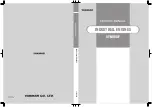
GEN III V8 ENGINE MANAGEMENT
Diagnostic Testing
One of the primary functions of the diagnostic management system is to perform diagnostic testing of system
operation The Diagnostic is the test or tests run on a system or component to determine if it is operating
according to specifications The different types of diagnostic tests include
• Passive
• Active
• Intrusive
Passive testing simply monitors the system or components during operation During Active testing, the PCM
controls the system or component in a specific action while monitoring takes place The PCM may perform
active tests as a result of failed passive tests The intrusive test is a special type of active test that involves an
action by the PCM that may affect vehicle performance or emissions
The Enable Criteria are the exact conditions required for a diagnostic to be run The enable criteria for any DTC
are listed under Conditions to Set as part of the diagnostic information in the Service Manual
Diagnostic testing occurs during a trip A Trip is a key-on cycle in which all the enable criteria for a given
diagnostic test are met, followed by a key-off / power-down Since the enable criteria for each DTC is different, a
trip for each DTC is different
The PCM counts warm-up cycles instead of key cycles to clear DTCs A warm-Up Cycle is achieved when the
engine coolant temperature rises at least 22°C from start-up and achieves a minimum temperature of 71 °C
The PCM also has the ability to learn from the results of its diagnostic testing The PCM internally charts the
results of diagnostic testing over a period of time and creates a baseline - the normal results of a test This is
called Statistical Filtering By using this learning capability, the PCM is able to filter out information that could
cause a false DTC to set
NOTE: The loss of battery power to the PCM will result in the loss of "learned" information. The PCM
will perform an aggressive testing schedule to relearn information. This mode of testing is called Quick
Learn and is not noticeable in most cases.
GEN III V8 ENGINE MANAGEMENT Page - 1 3
Summary of Contents for GEN III V8
Page 1: ...HOLDEN GEN III V8 ENGINE MANAGEMENT...
Page 3: ......
Page 4: ...GEN III V8 ENGINE MANAGEMENT CONTENTS SUBJECT GEN III V8 ENGINE MANAGEMENT...
Page 5: ...GEN III V8 ENGINE MANAGEMENT NOTES GEN III V8 ENGINE MANAGEMENT...
Page 7: ...GEN III V8 ENGINE MANAGEMENT Page 2 GEN III V8 ENGINE MANAGEMENT...
Page 8: ...GEN III V8 ENGINE MANAGEMENT Page 3...
Page 14: ...GEN III V8 ENGINE MANAGEMENT GEN III V8 ENGINE MANAGEMENT Page 9...
Page 16: ...GEN III V8 ENGINE MANAGEMENT GEN III V8 ENGINE MANAGEMENT Page 1 1...
Page 20: ...GEN III V8 ENGINE MANAGEMENT GEN III V8 ENGINE MANAGEMENT Page 15...
Page 25: ...GEN III V8 ENGINE MANAGEMENT NOTES Page 20 GEN III V8 ENGINE MANAGEMENT...
Page 29: ...GEN III V8 ENGINE MANAGEMENT Paqe 24 GEN III V8 ENGINE MANAGEMENT...
Page 30: ...GEN III V8 ENGINE MANAGEMENT GEN III V8 ENGINE MANAGEMENT Page 25...
Page 31: ...GEN III V8 ENGINE MANAGEMENT Page 26 GEN III V8 ENGINE MANAGEMENT...
Page 72: ...GEN III V8 ENGINE MANAGEMENT GEN III V8 ENGINE MANAGEMENT Page 67...
Page 85: ...GEN III V8 ENGINE MANAGEMENT Page 80 GEN III V8 ENGINE MANAGEMENT...
Page 90: ...GEN III V8 ENGINE MANAGEMENT GEN III V8 ENGINE MANAGEMENT Page 85...
Page 94: ...GEN III V8 ENGINE MANAGEMENT GEN III V8 ENGINE MANAGEMENT Page 89...
Page 104: ...GEN III V8 ENGINE MANAGEMENT GEN III V8 ENGINE MANAGEMENT Page 99...
Page 113: ...GEN III V8 ENGINE MANAGEMENT NOTES Page 108 GEN III V8 ENGINE MANAGEMENT...
















































